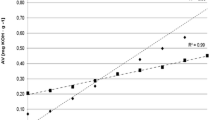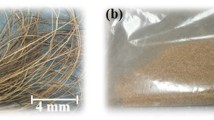Abstract
The chemistry of unsaturated oils used as binders for masonry units is under investigation, as it is likely to be relevant to their long term properties and may be used to improve the manufacturing requirements. The mixing process is followed by heat curing for 24 h, during which time the unit gains strength. The chemistry of this process has been assumed to be a complex series of oxidative and thermal reactions due to the double bonds present in the triacylglycerol (TAG) hydrocarbon chains, producing a heterogeneous, cross-linked solid matrix which encapsulates solid aggregates. A number of model samples and binder obtained from cured blocks were analysed via several NMR techniques. The reactions are characterised by consumption of polyunsaturated fatty acids (PUFA) and monounsaturated fatty acids (MUFA) and formation of oxygenated compounds, chain-shortened TAG, free fatty acids (FFA), di- and monoacylglycerols (DAG and MAG) and cross-linked material. The analysis facilitates identification of specific products and mechanisms of formation as the curing progresses, and evidence for instability of particular species in the matrix from samples retrieved after 6 months of storage.






Similar content being viewed by others

References
Zoorob S, Forth JP, Bailey HK (2006) Vegeblock: masonry units from recycled waste and vegetable oil. Solid waste technology and management. 511–520
Guillén MD, Ruiz A (2008) Monitoring of heat-induced degradation of edible oils by proton NMR. Eur J Lipid Sci Technol 110:52–60
Haywood RM, Claxson AWD, Hawkes GE, Richardson DP, Naughton DP, Coumbarides G, Hawkes J, Lynch EJ, Grootveld MC (1995) Detection of aldehydes and their conjugated hydroperoxydiene precursors in thermally-stressed culinary oils and fats—investigations using high-resolution proton NMR spectroscopy. Free Radic Res 22:441–482
Guillén MD, Ruiz A (2003) Rapid simultaneous determination by proton NMR of unsaturation and composition of acyl groups in vegetable oils. Eur J Lipid Sci Technol 105:688–696
Knothe G, Kenar JA (2004) Determination of the fatty acid profile by 1H NMR spectroscopy. Eur J Lipid Sci Technol 106:88–96
Marshall GL, Cudby MEA, Smith K, Harris RK (1988) 13C CP-MAS solid-state NMR spectra of stoving alkyd paints. Polymer 29:1501–1506
Lie Ken Jie MSF, Lam CC (1995) 1H-Nuclear magnetic resonance spectroscopic studies of saturated, acetylenic and ethylenic triacylglycerols. Chem Phys Lipids 77:155–171
Grosch W (1987) Reactions of hydroperoxides—products of low molecular weight. In: Chan HWS (ed) Autoxidation of unsaturated lipids. Academic Press, New York, pp 95–139
Sacchi R, Patumi M, Fontanazza G, Barone P, Fiordiponti P, Mannina L, Rossi E, Segre A (1996) A high-field 1H nuclear magnetic resonance study of the minor components in virgin olive oils. J Am Oil Chem Soc 73:747–758
Spyros A, Anglos D (2004) Study of aging in oil paintings by 1d and 2d NMR spectroscopy. Anal Chem 76:4929–4936
Hatzakis E, Agiomyrgianaki A, Kostidis S, Dais P (2011) High-Resolution NMR Spectroscopy: An Alternative fast tool for qualitative and quantitative analysis of diacylglycerol (DAG) Oil. J Am Oil Chem Soc 1–14
Neff WE, Frankel EN, Fujimoto K (1988) Autooxidative dimerization of methyl linolenate and its monohydroperoxides, hydroperoxy epidioxides and dihydroperoxides. J Am Oil Chem Soc 65:616–623
Gardner H, Kleiman R, Weisleder D (1974) Homolytic decomposition of linoleic acid hydroperoxide: identification of fatty acid products. Lipids 9:696–706
Oyman ZO, Ming W, van der Linde R (2006) Oxidation of 13C-labeled ethyl linoleate monitored and quantitatively analyzed by 13C NMR. Eur Polym J 42:1342–1348
Goicoechea E, Guillén MD (2010) Analysis of hydroperoxides, aldehydes and epoxides by 1H nuclear magnetic resonance in sunflower oil oxidized at 70 and 100 °C. J Agric Food Chem 58:6234–6245
Kenar J (2007) Functionalization of oleyl carbonate by epoxidation. J Am Oil Chem Soc 84:457–461
Aerts H, Jacobs P (2004) Epoxide yield determination of oils and fatty acid methyl esters using 1H NMR. J Am Oil Chem Soc 81:841–846
Guillén MD, Ruiz A (2005) Oxidation process of oils with high content of linoleic acyl groups and formation of toxic hydroperoxy- and hydroxyalkenals. A study by 1H nuclear magnetic resonance. J Sci Food Agr 85:2413–2420
Hämäläinen TI, Sundberg S, Mäkinen M, Kaltia S, Hase T, Hopia A (2001) Hydroperoxide formation during autoxidation of conjugated linoleic acid methyl ester. Eur J Lipid Sci Technol 103:588–593
Gardner HW (1989) Oxygen radical chemistry of polyunsaturated fatty acids. Free Radic Biol Med 7:65–86
Anderson M, Skerratt RG (2003) Variability study of incinerated sewage sludge ash in relation to future use in ceramic brick manufacture. Br Ceram Trans 102:109–113
Chimenos JM, Segarra M, Fernández MA, Espiell F (1999) Characterization of the bottom ash in municipal solid waste incinerator. J Hazard Mater 64:211–222
Acknowledgments
The authors are grateful to the Engineering and Physical Sciences Research Council for a Doctoral Training Grant, and to the solid state NMR service at Durham University for recording the solid state spectra.
Author information
Authors and Affiliations
Corresponding authors
About this article
Cite this article
Heaton, T., Fisher, J. & Forth, J.P. Waste Rapeseed Oil Used as a Binder for Masonry Units: NMR Spectroscopic Analysis. J Am Oil Chem Soc 89, 1101–1111 (2012). https://doi.org/10.1007/s11746-011-1984-8
Received:
Revised:
Accepted:
Published:
Issue Date:
DOI: https://doi.org/10.1007/s11746-011-1984-8



